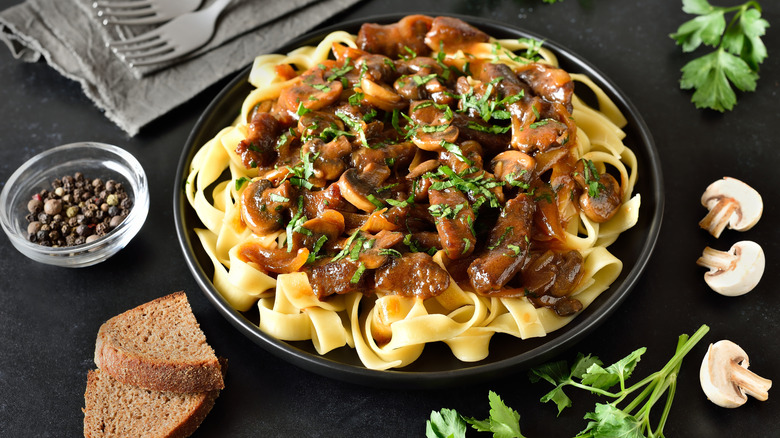The Best Cut Of Meat For Beef Stroganoff
We may receive a commission on purchases made from links.
If you're looking for a meat dish with abundant versatility, turn to beef stroganoff. Renditions appear in cuisines around the world, intertwined by just a few qualities: a creamy sauce, tender yet often inexpensive beef, and homey aromatics, all suited for serving over rice or pasta. Yet, as with other meat dishes, one of the central challenges is selecting the best cuts of beef for the job. You want a soft texture, yet not much fuss during preparation: Stroganoff doesn't entail the hours-long slow-cooking of a dish like beef bourguignon.
So to aid in grocery shopping for the dish, Chowhound luckily secured some exclusive advice from Stephanie Loaiza, one of the sisters from Six Sisters' Stuff, the brand behind several cookbooks, including "30-Minute Meals with Six Sisters' Stuff." Loaiza accounts for the variety of stroganoff recipes when choosing the best cut. "We want to look at two factors: your budget and your cooking method," she says. Based on which cut you select at the grocery store, you'll need to adapt your recipe, or vice versa.
Invest in a cut of beef that's initially tender, and Loaiza notes you can prepare stroganoff quickly on the stovetop. For this option, she says, "Opt for a more tender cut like a sirloin, or a marbled, pricier steak like a boneless ribeye." Simply sear the meat, check its internal temperature for desired doneness, then meld into the dish. Alternatively, with tougher cuts, you'll need to take the time to let collagen melt into gelatin. Here, Loaiza notes, "The cheaper option that produces the best results is a round steak." Throw this cut in the slow or pressure cooker, and a delicious stroganoff awaits.
Match the cooking technique with the right cut for the best beef stroganoff
There are several mistakes everyone makes when cooking beef stroganoff, with issues surrounding meat preparation being common pitfalls. Drowning the beef in a buttery, flavorful gravy doesn't remedy toughness. Sure, it helps with flavor — and does add moisture — but it won't compensate for unpalatable dry bites of beef. Regardless of the cut and technique you use, there's no way to salvage rubbery beef. Subsequently, Stephanie Loaiza cautions overcorrecting: "Just be sure to not overcook to avoid a chewier texture."
Let a round steak spend too long in the pressure cooker or overcook when seared on the stove, and it's easy to see why it's one of the worst to make at home. Yet patiently braise it for around an hour, and its beefy flavor delights. As Loaiza says, "The fibrous meat will break down nicely when slow cooked or pressure cooked, leaving you with a tender, juicy meat that pairs perfectly with the savory sauce." The slow-cooking process thereby transforms an inexpensive cut.
Meanwhile, when opting for a fattier steak cut, aim to achieve a medium rare doneness. First, sear the beef, delectably browning the sides, while slightly undercooking the interior. Then let the meat rest, before mixing in the sauce, cooking for only a minute. By delicately balancing the cut with perfect timing, you'll achieve the ideal bite of beef stroganoff.

